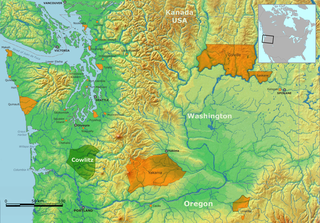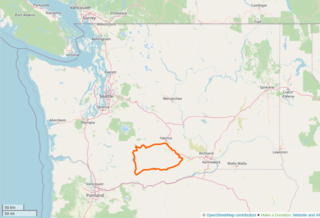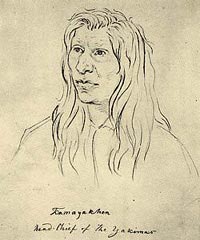
Yakima is a city in, and the county seat of, Yakima County, Washington, United States, and the state's 11th most populous city. As of the 2020 census, the city had a total population of 96,968 and a metropolitan population of 256,728. The unincorporated suburban areas of West Valley and Terrace Heights are considered a part of greater Yakima.

Toppenish is a city in Yakima County, Washington. As of the 2020 census, the city population was 8,854. It is located within the Yakama Indian Reservation, established in 1855.

White Swan is a census-designated place (CDP) in Yakima County, Washington, United States. The population was 3,033 at the 2000 census.

The Yakama are a Native American tribe with nearly 10,851 members, based primarily in eastern Washington state.

The term Cowlitz people covers two culturally and linguistically distinct indigenous peoples of the Pacific Northwest; the Lower Cowlitz or Cowlitz proper, and the Upper Cowlitz / Cowlitz Klickitat or Taitnapam. Lower Cowlitz refers to a southwestern Coast Salish people, which today are enrolled in the federally recognized tribes: Cowlitz Indian Tribe, Quinault Indian Nation, and Confederated Tribes of the Chehalis Reservation. The Upper Cowlitz or Taitnapam, is a Northwest Sahaptin speaking people, part of the Confederated Tribes and Bands of the Yakama Nation.

Chinookan peoples include several groups of Indigenous people of the Pacific Northwest in the United States who speak the Chinookan languages. Since at least 4000 BCE Chinookan peoples have resided along the Lower and Middle Columbia River (Wimahl) from the river's gorge downstream (west) to the river's mouth, and along adjacent portions of the coasts, from Tillamook Head of present-day Oregon in the south, north to Willapa Bay in southwest Washington. In 1805 the Lewis and Clark Expedition encountered the Chinook Tribe on the lower Columbia.

The Yakama Indian Reservation is a Native American reservation in Washington state of the federally recognized tribe known as the Confederated Tribes and Bands of the Yakama Nation. The tribe is made up of Klikitat, Palus, Wallawalla, Wanapam, Wenatchi, Wishram, and Yakama peoples.

The history of Washington includes thousands of years of Native American history before Europeans arrived and began to establish territorial claims. The region was part of Oregon Territory from 1848 to 1853, after which it was separated from Oregon and established as Washington Territory following the efforts at the Monticello Convention. On November 11, 1889, Washington became the 42nd state of the United States.

The Yakima War (1855–1858), also referred to as the Plateau War or Yakima Indian War, was a conflict between the United States and the Yakama, a Sahaptian-speaking people of the Northwest Plateau, then part of Washington Territory, and the tribal allies of each. It primarily took place in the southern interior of present-day Washington. Isolated battles in western Washington and the northern Inland Empire are sometimes separately referred to as the Puget Sound War and the Coeur d'Alene War, respectively.

Cheshiahud and his family on Lake Union, Seattle, Washington in the 1880s are, along with Princess Angeline, among the few late-19th century Dkhw'Duw'Absh about whom a little is known. In the University of Washington (UW) Library image archives, he is called Chudups John or Lake Union John. His family were among the few of the Duwamish people who did not move from Seattle to the Port Madison Reservation or other reservations. They lived on Portage Bay, part of Lake Union, when a photo was taken around 1885. According to the Duwamish Tribe, Lake John had a cabin and potato patch at the foot of Shelby Street. A commemorative plaque of unknown reliability is said to exist at the eastern foot of Shelby. This land was given to him by Seattle pioneer David Denny or the property was purchased—see below. Photographer Orion O. Denny recorded Old Tom and Madeline, ca. 1904, further noted in the UW Library archives as Madeline and Old John, also known as Indian John or Cheshishon, who had a house on Portage Bay in the 1900s, south of what is now the UW campus although native people had been prohibited from residence in Seattle since the mid-1860s.

Kamiakin (1800–1877) (Yakama) was a leader of the Yakama, Palouse, and Klickitat peoples east of the Cascade Mountains in what is now southeastern Washington state. In 1855, he was disturbed by threats of the Territorial Governor, Isaac Stevens, against the tribes of the Columbia Plateau. After being forced to sign a treaty of land cessions, Kamiakin organized alliances with 14 other tribes and leaders, and led the Yakima War of 1855–1858.

Qualchan was a 19th-century Yakama chieftain who participated in the Yakama War with his Uncle Kamiakin and other chieftains.
United States v. Winans, 198 U.S. 371 (1905), was a U.S. Supreme Court case that held that the Treaty with the Yakima of 1855, negotiated and signed at the Walla Walla Council of 1855, as well as treaties similar to it, protected the Indians' rights to fishing, hunting and other privileges.
Events from the year 1855 in the United States.

The Battle of Toppenish Creek was the first engagement of the Yakima War in Washington. Fought on October 5, 1855, a company of American soldiers, under Major Granville O. Haller, was attacked by a band of Yakamas, under Chief Kamiakin, and compelled to retreat. The battle occurred in Yakima Valley, 113 miles northwest of Fort Walla Walla, along Toppenish Creek and was a major victory for Native American forces.

Andrew Jackson Bolon was a Bureau of Indian Affairs agent whose 1855 death at the hands of renegade Yakama is considered one of several contributing factors in the outbreak of the Yakima War. Some sources assert Bolon was the first law enforcement officer killed in the line of duty in the territory that is now the state of Washington, though the Washington Peace Officers Memorial in Olympia, Washington lists a King County sheriff's deputy killed the year before Bolon's death.

Cutmouth John, also known as Poor Crane and as Ya-Tin-Ee-Ah-Witz, Chief of the Cayuses, was a Native American who served in the U.S. Army Indian Scouts. His lineage unclear, some considered him a member of the Umatilla, or Wasco tribes.
Ahtanum Creek is a tributary of the Yakima River in the U.S. state of Washington. It starts at the confluence of the Middle and North Forks of Ahtanum Creek near Tampico, flows along the north base of Ahtanum Ridge, ends at the Yakima River near Union Gap and forms a portion of the northern boundary of the Yakama Indian Reservation. The name Ahtanum originates from the Sahaptin language, which was spoken by Native Americans in the region.

Frenchtown was a historical Pacific Northwest settlement established by Métis and French Canadian fur traders. It was located in Walla Walla County, Washington, United States. Originally called "le village des Canadiens", it became known as "Frenchtown" by later settlers similar to other settlements such as Frenchtown, Montana. It has also been referred to as "Walla Walla Frenchtown", This Pacific Northwest historical place has become legally recognized through a registered historical foundation. After most French Canadian and Métis residents were expelled in 1855, the area was largely resettled by Americans and the community closest to it was renamed to Lowden in 1915.
Patricia 'Patsy' L. Whitefoot is a member of Yakama Nation, is Indigenous elder, activist and professional educator along with being the traditional food gatherer for the Toppenish Creek Longhouse. She served as the President of the National Indian Education Association and President Obama appointed her as a member of the National Advisory Council on Indian Education. She is a prominent advocate for Missing and Murdered Indigenous Women, and Indigenous rights.
















